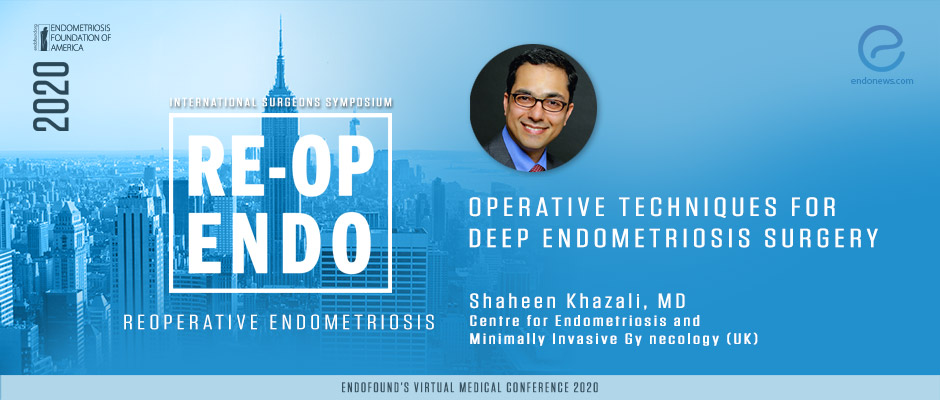Operative techniques for Deep Endometriosis Surgery - Shaheen Khazali, MD
Jan 11, 2021
The technique used in endometriosis surgery should be decided on a case-by-case basis and surgeons should treat the individual patient, not the disease per se.
Key Points
Information about the presenter: This presentation is by Dr. Shaheen Khazali M.D., an expert endometriosis surgeon who leads the endometriosis center at St. Peter’s Hospital in the U.K. Dr. Khazali is also the Honorary Secretary of the British Society for Gynaecological Endoscopy (BSGE), the Honorary Secretary of the International Society of Neuropelveology (ISON), and an Honorary senior lecturer at Royal Holloway, University of London. Dr. Khazali’s presentation is titled “Operative techniques for Deep Endometriosis Surgery”.
Highlights:
- Good knowledge of the anatomy of the peritoneal space, a good team, and good tools are essential for successful endometriosis surgery.
- Following SOSURE (Survey and sigmoid mobilization, Ovarian mobilization, Suspension of the uterus and ovaries, Ureterolysis, Rectovaginal-pararectal space entry, and Excision) can ensure the best outcome is achieved.
Importance:
- The technique used in endometriosis surgery should be decided on a case-by-case basis and surgeons should treat the individual patient, not the disease per se.
Remarks:
- Endometriosis is an enigmatic disease.
- The disease is like an iceberg and might be much deeper than what can be seen laparoscopically.
- Excision is almost always better than ablation.
- Fertility should be considered when conducting excision surgery for endometriomas as the ovarian reserve will drop following endometrioma excision.
- The first surgery is the best surgery.
- Tools should be used as a knife and fork with two hands.
- A structured approach to endometriosis surgery is key.
- Gastrointestinal endometriosis should be completely removed or not touched.
- Nerves matter.
Lay Summary
In this presentation, Dr. Shaheen Khazali, an endometriosis surgeon specialized in gastrointestinal and urinary tract endometriosis excision and in neuropelveology, talks about the general principles and some techniques for endometriosis surgery focusing on rectovaginal endometriosis. He also describes the "ten rules of endometriosis surgery".
According to Dr. Khazali, the fundamentals of endometriosis surgery are the same as any other surgery and anatomical knowledge is key. “We need to know our anatomy and revise even when you have been doing this for years,” he says and adds that sometimes it is necessary to go back to the books and revise and remember the anatomy of the pelvic sidewalls and the deep nerve structures.
Dr. Khazali also talks about the importance of having a structured approach to endometriosis surgery, not only for the surgeon but also for the rest of the team. He says that the time spent on optimizing the exposure and access is time well spent and cutting corners in endometriosis surgery often costs time at best and causes complications for the patient at worse. He also stresses the importance of preparation and of having the right team, equipment, and support, as well as being familiar with the peritoneal space.
Then, Dr. Khazali introduces the mnemonic that he and his team use to ensure the best outcome is achieved. SOSURE stands for survey and sigmoid mobilization, ovarian mobilization, suspension of the uterus and ovaries, ureterolysis the surgical procedure that exposes the ureter to free it from adhesions or to avoid injury to it during surgery, rectovaginal and pararectal space entry, and excision of all endometriosis. However, he adds that no all these steps are required in all cases and that they do not need to be done in this order.
Dr. Khazali then moves on to showing some surgery videos to illustrate his and his team’s approach. The first is an example of a butterfly excision for the removal of both pelvic sidewalls, uterosacral ligaments, and torus uterinus and demonstrates the importance of ovarian and uterine suspension. The second video shows the removal of bladder nodules, which does not necessitate ovarian or uterine suspension.
Following the videos, Dr.Khazili talks about the different approaches such as shave, disc, or segmental bowel resection that can be used to treat endometriosis and stresses that the technique that is used depends on how far the disease has gone and the individual patient. “In young healthy women, segmental bowel resection is not as big a deal as it might be for elderly cancer patients,” he says.
Dr. Khazili then talks about the different endometriosis surgeon camps from those who think endometriosis should be treated like cancer removing every cell even if the patient does not have any symptoms, to those who think patients should no be operated on but treated medically. “I belong to the camp that says you excise the disease completely when there is a good indication to do so in the right patient, and within reason”, he says. He adds: “We are treating the patient, not the disease.”
To conclude his presentation Dr. Khazili invites listeners to join the British Society for Gynaecological Endoscopy (BSGE) Facebook group to keep in touch and be part of clinical discussions about endometriosis surgery.
Research Source: https://www.endofound.org/operative-techniques-for-deep-endometriosis-surgery-shaheen-khazali-md?pop=mc
endometriosis surgery excision surgery sigmoid pararectal ovarian suspension ureter bladder facebook SOSURE mobilization mc2020

